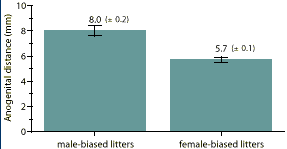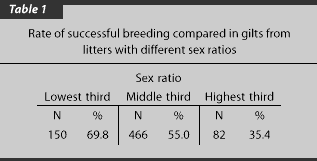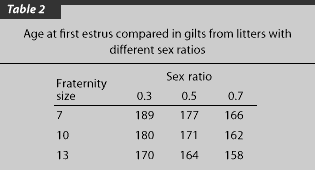What's your interpretation? |
This Þgure (Figure 1) shows that anogenital distance at birth is signiÞcantly longer in gilts born in litters with more males (male-biased litters) than in gilts from litters with more females (female-biased litters). Sex ratio is the ratio of males to females in a litter. Can you tell any other differences between gilts from litters with different sex ratios?
Reproductive performance and birth litter sex ratio of gilts
Phenomenon
 Figure 1 (on the front cover) demonstrates a significant difference
in anogenital distances at birth between gilts from male-biased litters
(8.0 mm) and those from female-biased litters (5.7 mm).1 This
suggests that there might be differences in reproductive performance between
gilts from male-biased litters and those from female-biased litters. Recent
studies to test this hypothesis have observed the following:
Figure 1 (on the front cover) demonstrates a significant difference
in anogenital distances at birth between gilts from male-biased litters
(8.0 mm) and those from female-biased litters (5.7 mm).1 This
suggests that there might be differences in reproductive performance between
gilts from male-biased litters and those from female-biased litters. Recent
studies to test this hypothesis have observed the following:
- Gilts from male-biased litters have a lower pregnancy rate compared
with gilts from female-biased litters in the first breeding attempt.1
Females are significantly more likely to exhibit lower rates of successful
breeding during their first four breeding attempts if they were born in
a male-biased litter (Table 1).1

- Age at first estrus decreased as the proportion of males increased
in a litter (Table 2).2

Mechanisms
Differences in anogenital distances at birth, successful breeding, and age at first estrus between gilts from litters with more males and those from litters with more females may be influenced by the endocrine environment to which gilts are exposed in the uterus. Testes of the fetal male secrete testosterone during a critical period in the differentiation of internal and external genitalia. Females positioned between two males are most affected, and females between two females are least affected in rodent studies.
Implications
When selecting gilts to serve as replacements in the breeding herd, it is best to avoid gilts from litters of 12 or more pigs that are >= 67% males.1
References
1. Drickamer LC, Arthur RD, Rosenthal TL. Conception failure in swine: Importance of the sex ratio of a female's birth litter and tests of other factors. J Anim Sci. 1997; 75:2192-2196.
2. Lamberson WR, Blair RM, Parfet KAR, Day BN, Johnson RK. Effect of sex ratio of the birth litter on subsequent reproductive performance of gilts. J Anim Sci. 1988;66:595-598.
